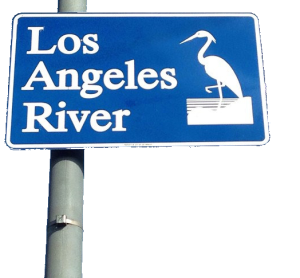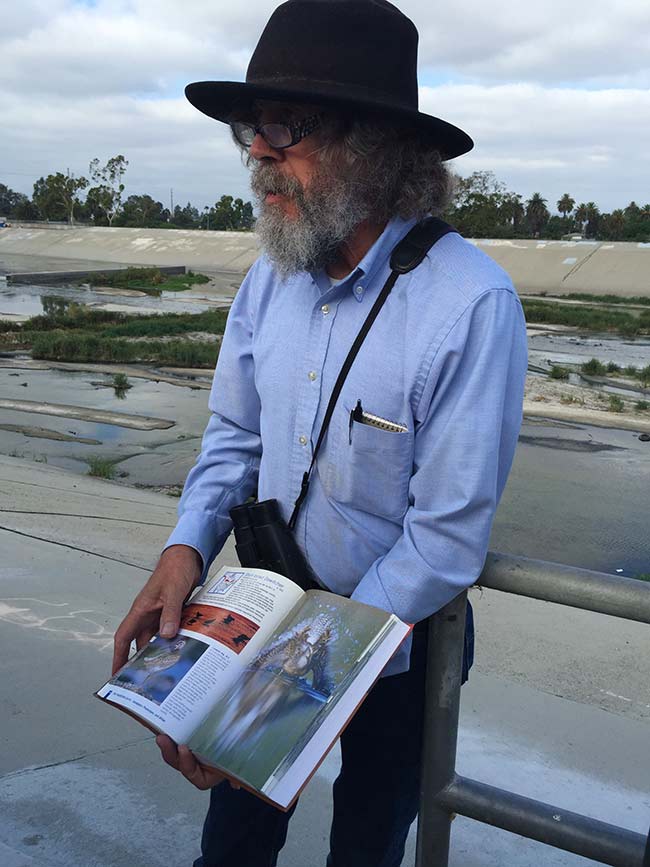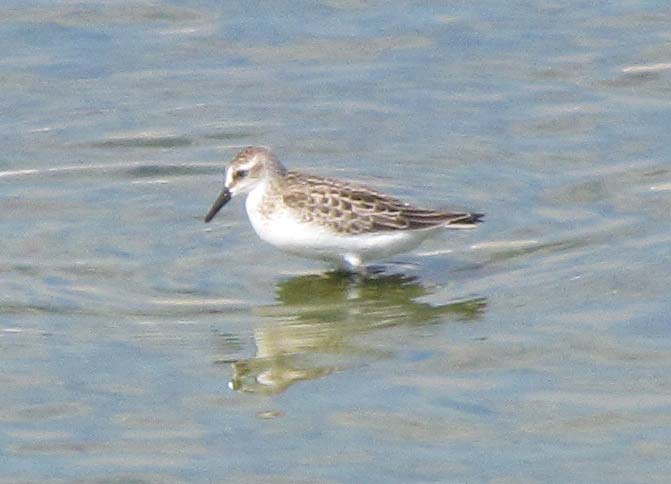Saturday brought an annual birding trip to the lower LA River with the Pasadena Audubon. This trip was timed to take advantage of the birds returning for the winter and for the migrating birds passing through. Little did I know that we would be spotting a rare bird that had been recently reported in the area, read on to find out what bird we saw.

The LA River gained more respect as a river (rather than just a storm runoff channel) when attractive signs adorning a heron were placed at every bridge that crosses it. The installation of these signs was the result group effort led by Lewis MacAdams and Friends of Los Angeles River. While much of the LA River is a dry, shallow stream, there are parts of it that expand and offer islands of vegetation and ample shallow current perfect for shorebirds, fish, and other wildlife. In these areas, you will find many different species of birds: sandpipers, avocets, stilts, dowitchers, gulls, and more.
This was my first time birding at the LA River. We met up at the river near Willow Street off the 710 freeway in Long Beach. Parking was easy to find in the residential neighborhood adjacent to the river. The birders were quick to spot, as they were sporting their standard sun hats and drab, khaki-colored clothing. The entire bird walk was spent hugging the edge of the LA River bike path. Bicycle clicks, hums, irritated biker warning shouts, and bird calls were the soundtrack to the morning. Our leader, Larry Allen, was very experienced with tricky shorebird identification and spent time to point out common birds that we were going see.
Right from the beginning, many groups of shorebirds were visible. I watched large flocks of Black-necked Stilts run around and harass each other. Elegant American Avocets stood around and picked through the water, while dozens of small Western Sandpipers scurried about on all sides unable to decide on a direction to go.

Larry spent some time explaining how to the difference between Long-billed and Short-billed Dowitchers. The tl;dr is to first spot juveniles in the group (their plumage looks fresh, rich, and unworn). Once a juvenile has been spotted, look for black and gray tiger striping on their tertial feathers. If the tertial feathers have this striping, it indicates you are looking at a Short-billed Dowitcher. Long-billed Dowitchers have solid gray tertials. There are also a few other less-reliable field indicators to tell the difference, but I don’t feel comfortable making the call even with this differentiator. Bird calls are also used to confirm the presence of both species in mixed groups. Only more experience will bring confidence identifying these critters in the field. Until then, you can always default to the “Short-billed/Long-billed Dowitcher” option in eBird.

Following the Dowitcher lecture, we continued our way up the river to view more groups of birds. In the middle of the river was a long island of bushes and vegetation, it was here that I heard a fellow birder say a Northern Red Bishop was spotted. I didn’t see it at first but was told it would reappear every couple of minutes. After observing the island for a few moments, a bright red/orange spot appeared. Peering at it through my binoculars, I was able to easily confirm my very first sighting of a bishop! These adorable birds have bright, fanciful plumage and a black beak/face.
Caspian Terns with their thick, red bills slowly flapped past as we arrived at the next group birds. This group brought many more dowitchers and Western Sandpipers—but the group was in search of something else. A rare bird that looks almost identical in every way to the Western Sandpiper was reported in this area few days prior—the Semipalmated Sandpiper. This bird (a common appearance on the East Coast), has a slightly shorter bill than the Western , without any curvature at all. My extremely mediocre shorebird ID skills would have never glanced twice at this bird, but, lo and behold, it was spotted quite quickly by a member in our party. Without my camera, I tried digiscoping photos of this bird with my iPhone, but ended up with photos of every bird but the semipalmated.

Our group turned around at this point and started to head back downstream toward areas with more trees and deeper waters. Several participants of the bird walk bowed out at this point due to the heat and left satisfied with the rare sighting of the day. Along the way I had a nice talk with a woman named Beatrix whose son won the ABA Young Birder of the Year Award. We spoke about how we got into birding, about school, careers, and the like.
Snowy Egrets dotted the shore on the way to the lower stream; a juvenile one with solid yellow legs was among the adults (who normally have black legs with yellow feet). Just before arriving, we spotted about five White-faced Ibises flying by (first time I’ve seen these in LA, I saw them a the Great Salt Lake previously). The reward for heading downstream past our starting point was witnessing a beautiful Osprey hunt for food. The Osprey glided back and forth diving into the water or swooping down within inches of it trying to snag a tasty fish. After about ten or so tries, the bird was rewarded with lunch.
By this point, the heat was too much for me and I called it a day. Check out my eBird Checklist for a full list of spotted we spotted while birding at LA River.
Here’s a photo of the rare bird of the day, the Semipalmated Sandpiper. Notice how it looks basically identical to the bird above except the shorter, stubbier bill.

